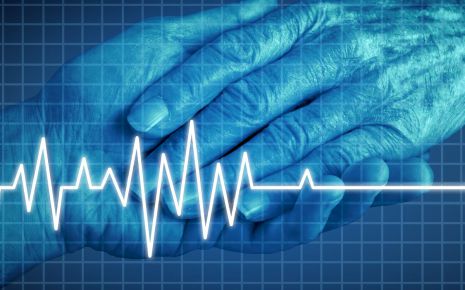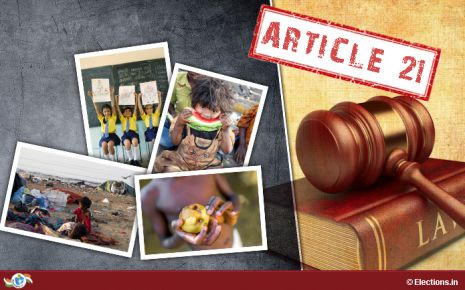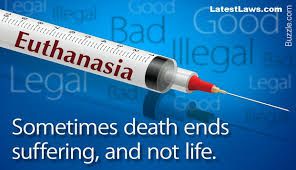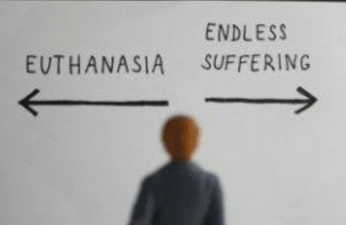Euthanasia: Indian Perspective
"It has been often said, that it is not death, but dying, which is
terrible."-Â Henry Fielding
This article focuses on the concept of Euthanasia and its legality in India. It zooms on the relevant Indian laws which are in accordance with the notion of Euthanasia and reviews them. The article distinguishes the theories and practices and provides an impartial view of them. The article also talks about the modern practices, legality, and upcoming modern trends of the notion.
Every person reserves a right to life, in which he can live his life to the fullest enjoyment and for a lengthy period. But there are certain circumstances where a person does not want to live and just ends his life. For ending one's own life there are 2 means one of the two is Suicide and the other is Euthanasia. Former is illegal in India, which Accomplishment will land you in heaven (probably) and failed attempt of the same will land you in jail while the Latter one i.e. euthanasia is a debatable topic.
Euthanasia is a practice or an act, in which a person suffering from a painful and incurable disease is put to death to end the suffering of that person. When a person who is sick or hurt or has an incurable disease where the patient is suffering a lot and cannot bear such pain or doesn't wish to live in such painful condition, wishes for a silent and painful death also known as euthanasia.
Francis Bacon coined the term ''Euthanasia' for the first time. It is derived from the two Greek words, "EU" and "Thanatos" meaning "good death". The term 'Mercy killing' is also used as replaceable for 'euthanasia'. Over the years, the term euthanasia has evolved too many meanings "a good death", "assisted dying", "death with dignity", etc. In common words, Euthanasia is the practice of intentional killing of a person, whose life is felt not worth living.
Â
When a person commits suicide it becomes no criminal offense but if the person fails in such an attempt to commit suicide it becomes a criminal offense i.e. stated in section 309 of IPC, 1860 which attracts the maximum punishment of imprisonment up to 1 year. In the case of euthanasia, only passive euthanasia is legal in India, active euthanasia still stands illegal.
Â
Back when passive euthanasia was also considered illegal and the doctors who were performing such acts of euthanasia, came under the purview of section 300 exception 5 of India Penal Code, 1860. Since there was a requisite 'intention' on part of doctors to cause the death of their patients amounting to their voluntary consent, they were made liable under the offense of section 304 i.e. culpable homicide not amounting to murder. However, this stands only in the concept of voluntary euthanasia, where a person above 18 years of age gives voluntary consent. In non-voluntary and involuntary euthanasia, it will be obstructed by the 1st proviso of section 92 of the IPC, 1860.
In the case of P. Rathiram vs. Union of India (1994)[2], it was held that section 309 of IPC, 1860 violates constitutional provisions as it was in derogation of Article 21 of the Constitution of India, which pertains to the right to life and personal liberty, an individual should be free to choose the course of action of his life which is guaranteed under the Constitution of India.
However, in the case of Gian Kaur vs. the State of Punjab[3], the appellant and her husband were charged under section 306 of IPC, 1860 i.e. abetment to suicide of their daughter in law. The trial court convicted the accused of the said offense u/s 306 IPC, 1860, which was upheld by the High Court. Appellant challenged the constitutionality of section 306 as well as whether Section 309 violates Article 21 in the Supreme Court of India. In the appeal, the Appellant concluded that 'right to die' is included in Article 21 i.e.
Right to life, and any person committing any action under section 306 is merely helping that person to enforce his fundamental right which is guaranteed under article 21 of the constitution of India. Hence, Punishment for the act of section 306 should violate the fundamental right and should be declared unconstitutional. The constitutional bench of the Apex court declared that the 'right to life under article 21 does not include 'right to die. The court upheld the constitutional validity of sections 306 and 309 of IPC, 1860
The Indian Psychiatric Society had recommended the Law Commission prepare a report on the concept of euthanasia. The Law Commission through the way of suo moto took up the issue and submitted a report recommending the Government initiate steps for repeal of section 309 IPC. The Report discussed the constitutionality and validity of the subject and made necessary findings and considered the law to be inhumane, irrespective of whether it is constitutional or unconstitutional, and shall be deleted.
In the Supreme Court in the landmark case of Aruna Ramchandra Shanbaug v. Union of India[4], passive euthanasia was made legal without any legislation statute or an act but under the guidelines provided. However, active euthanasia was precluded from functioning and was considered illegal till the legislation passes an act for functioning and its regulation and make it legal. Further, the court ruled that active euthanasia is a criminal offense under section 302 or at least 304 of IPC, and the doctors executing such euthanasia as physician-assisted suicide (PAS) will be made liable under section 306 of IPC.
The court in this case also laid down a procedure that started with the filing of an application to the chief justice of the high court by the petitioner requiring the high court to decide on approving passive euthanasia. For adjudicating this matter the bench should consist of a minimum of two judges bench. The bench should seek the opinion of a committee of three doctors, nominated after consulting the necessary doctors and medical professionals.
After the appointment of such doctors in a committee, the high court shall issue notice to the family parents, spouse, and siblings and in their absence a friend of the patient along with the report of the committee. Upon receiving such a report the final verdict lies before the High Court. This procedure was established by the Supreme Court for the purpose to make the process of euthanasia free from any will or evil ulterior motives of the kin of the petitioner.
Â
Conclusion
Euthanasia is an act that is considered negative and immoral but is done in a bonafide manner. The intention behind the concept is not to take the life of a person but to relieve the person by way of death who is suffering excruciating pain. The biggest setback of applying euthanasia is the misuse. Euthanasia can be used for negative purposes and for gaining unlawful benefits from the deceased and can be used against the will of such a deceased person.
The practice of euthanasia in some countries it is considered to be valid and legal the countries approving the culture of euthanasia are of a view that the person should not suffer much but rather should die with dignity. It has been often said, that it is not death, but dying, which is terrible. On the other hand, many countries are of a view regarding euthanasia that either it is immoral to kill someone or the concept and intent of euthanasia will be misused for personal gains.
In India, the rule of law is still not followed in some places, and corruption, coercion, and undue influence will play the role of barriers to the practice of euthanasia and there will be more murders in the name of euthanasia rather than bonafide euthanasia. Therefore, in my opinion, both views are correct but there should be a creation of a middle way which should develop euthanasia and should be adopted by more countries.
End-Notes:
This article focuses on the concept of Euthanasia and its legality in India. It zooms on the relevant Indian laws which are in accordance with the notion of Euthanasia and reviews them. The article distinguishes the theories and practices and provides an impartial view of them. The article also talks about the modern practices, legality, and upcoming modern trends of the notion.
Every person reserves a right to life, in which he can live his life to the fullest enjoyment and for a lengthy period. But there are certain circumstances where a person does not want to live and just ends his life. For ending one's own life there are 2 means one of the two is Suicide and the other is Euthanasia. Former is illegal in India, which Accomplishment will land you in heaven (probably) and failed attempt of the same will land you in jail while the Latter one i.e. euthanasia is a debatable topic.
Euthanasia is a practice or an act, in which a person suffering from a painful and incurable disease is put to death to end the suffering of that person. When a person who is sick or hurt or has an incurable disease where the patient is suffering a lot and cannot bear such pain or doesn't wish to live in such painful condition, wishes for a silent and painful death also known as euthanasia.
Francis Bacon coined the term ''Euthanasia' for the first time. It is derived from the two Greek words, "EU" and "Thanatos" meaning "good death". The term 'Mercy killing' is also used as replaceable for 'euthanasia'. Over the years, the term euthanasia has evolved too many meanings "a good death", "assisted dying", "death with dignity", etc. In common words, Euthanasia is the practice of intentional killing of a person, whose life is felt not worth living.
Â
Types of Euthanasia
- Active Euthanasia:
This is a type of euthanasia where a doctor can end a person's life instantly. It includes the use of highly lethal drug doses which are injected into the patient directly into the blood or in such a way that a person dies instantly. The people who are suffering from incurable pain and want to end their lives to end their painful suffering opt for euthanasia. This type of euthanasia is often voluntary but also can be non-voluntary where a person is not in a condition to give any such consent. The other terms used for active euthanasia are 'Positive Euthanasia' and 'Aggressive Euthanasia'.
 - Passive Euthanasia:
This type of euthanasia is a practice of intentionally causing the death of a person whereby the necessary and basic items such as food, water, and drugs, which are necessary to survive, are withdrawn from giving it to the patient to provide death to such a person who is suffering from excessive pain and is not in a condition to get better from any disease or injury. In simple terms, removing life support and letting the death of such a patient through natural phenomenon. It is a slower type of death in comparison with active euthanasia. The other terms used for negative euthanasia are 'Negative Euthanasia' and 'Non-Aggressive Euthanasia'.
 - Voluntary Euthanasia:
When an individual gives consent consciously to end one's own life then it is called Voluntary Euthanasia. The core element of this is, that it should be consented to with full assent and with full understanding.
 - Non-Voluntary Euthanasia:
When an individual is not in a position to give consent because of his non-consciousness, a decision to end that person's life is given by some other person such as a family member or his life partner is called Non-voluntary Euthanasia.
Suicide vs. Euthanasia
Suicide and euthanasia both are conceptually separate and cannot be linked as one. When a person commits suicide it is because of several reasons such as depression, bad relationship, lack of success, or financial issues. Whereas euthanasia is a different concept where another individual takes measures to end another's personal life to relieve him from any incurable pain or suffering, which should be bonafide i.e. act done in a good faith.When a person commits suicide it becomes no criminal offense but if the person fails in such an attempt to commit suicide it becomes a criminal offense i.e. stated in section 309 of IPC, 1860 which attracts the maximum punishment of imprisonment up to 1 year. In the case of euthanasia, only passive euthanasia is legal in India, active euthanasia still stands illegal.
Â
Position of India on Euthanasia
In India, there are no laws about euthanasia provided by the legislature. Indian courts recognize only passive euthanasia. In a recent case of Common Cause v. Union of India[1], it was held that the 'right to die with dignity is a fundamental part of human life. It can be availed by the patients who are suffering from severe pain and incurable and prolonged diseases and are in a permanent vegetative state, where there is less or no hope of recovery and are generally on the verge to die a painful death, where they are kept alive through external instruments and machines. In such cases, passive euthanasia can be permissible.Back when passive euthanasia was also considered illegal and the doctors who were performing such acts of euthanasia, came under the purview of section 300 exception 5 of India Penal Code, 1860. Since there was a requisite 'intention' on part of doctors to cause the death of their patients amounting to their voluntary consent, they were made liable under the offense of section 304 i.e. culpable homicide not amounting to murder. However, this stands only in the concept of voluntary euthanasia, where a person above 18 years of age gives voluntary consent. In non-voluntary and involuntary euthanasia, it will be obstructed by the 1st proviso of section 92 of the IPC, 1860.
The link between Sections 306 and 309 IPC, 1860 With Article 21 of the Constitution of India
In India, attempt to suicide and abetment to suicide both are punishable offenses under sections 309 and 306 of the Indian penal code, 1860 respectively.In the case of P. Rathiram vs. Union of India (1994)[2], it was held that section 309 of IPC, 1860 violates constitutional provisions as it was in derogation of Article 21 of the Constitution of India, which pertains to the right to life and personal liberty, an individual should be free to choose the course of action of his life which is guaranteed under the Constitution of India.
However, in the case of Gian Kaur vs. the State of Punjab[3], the appellant and her husband were charged under section 306 of IPC, 1860 i.e. abetment to suicide of their daughter in law. The trial court convicted the accused of the said offense u/s 306 IPC, 1860, which was upheld by the High Court. Appellant challenged the constitutionality of section 306 as well as whether Section 309 violates Article 21 in the Supreme Court of India. In the appeal, the Appellant concluded that 'right to die' is included in Article 21 i.e.
Right to life, and any person committing any action under section 306 is merely helping that person to enforce his fundamental right which is guaranteed under article 21 of the constitution of India. Hence, Punishment for the act of section 306 should violate the fundamental right and should be declared unconstitutional. The constitutional bench of the Apex court declared that the 'right to life under article 21 does not include 'right to die. The court upheld the constitutional validity of sections 306 and 309 of IPC, 1860
The Indian Psychiatric Society had recommended the Law Commission prepare a report on the concept of euthanasia. The Law Commission through the way of suo moto took up the issue and submitted a report recommending the Government initiate steps for repeal of section 309 IPC. The Report discussed the constitutionality and validity of the subject and made necessary findings and considered the law to be inhumane, irrespective of whether it is constitutional or unconstitutional, and shall be deleted.
In the Supreme Court in the landmark case of Aruna Ramchandra Shanbaug v. Union of India[4], passive euthanasia was made legal without any legislation statute or an act but under the guidelines provided. However, active euthanasia was precluded from functioning and was considered illegal till the legislation passes an act for functioning and its regulation and make it legal. Further, the court ruled that active euthanasia is a criminal offense under section 302 or at least 304 of IPC, and the doctors executing such euthanasia as physician-assisted suicide (PAS) will be made liable under section 306 of IPC.
The Court gave the following safeguards and conditions:
- A decision has to be taken to turn off the life support provided to the
patient either by the parents or the spouse or other relatives or in the
absence of any of them, such a decision should be taken by a person acting
as his next friend. It can be taken by the doctors attending to the patient.
However, the decision of euthanasia should be bona fide i.e. in the best
interest of the patient.
 - Even if the decision is taken by the near relatives or doctors or next friend to withdraw or pull out the life support of the patient, such a decision should be required to be taken after the approval of the High court.
The court in this case also laid down a procedure that started with the filing of an application to the chief justice of the high court by the petitioner requiring the high court to decide on approving passive euthanasia. For adjudicating this matter the bench should consist of a minimum of two judges bench. The bench should seek the opinion of a committee of three doctors, nominated after consulting the necessary doctors and medical professionals.
After the appointment of such doctors in a committee, the high court shall issue notice to the family parents, spouse, and siblings and in their absence a friend of the patient along with the report of the committee. Upon receiving such a report the final verdict lies before the High Court. This procedure was established by the Supreme Court for the purpose to make the process of euthanasia free from any will or evil ulterior motives of the kin of the petitioner.
Â
Arguments against Euthanasia
- Violative of basic rights guaranteed under the constitution of India.
- Immoral use of Euthanasia. There is a possibility of misusing Euthanasia by the family members of the patient to get inheritance assets from the death of such a person
- Disposing of a deceased person from the civilized society.
- Loss in the commercialization of the health care industry, as relatives of patients will take this as a selective to avoid huge cost on the treatment of such person.
Arguments by Euthanasia Supporters
- Right to die with dignity. Patients in a vegetative state who are not in a condition to be treated and recover can die from euthanasia to avoid the financial burden on the family members and can die with dignity.
- Euthanasia not only gives one 'the right to dignity but also helps other humans in getting organ transplants.
- It eliminates the burden from the shoulders of the family members to take care of the patient suffering from an incurable disease.
- Active euthanasia should be permitted and allowed, its supporters emphasize that when the condition of the patients who are suffering from incurable disease conditions has become burdensome shall be allowed to die with dignity instantly from active euthanasia.
Conclusion
Euthanasia is an act that is considered negative and immoral but is done in a bonafide manner. The intention behind the concept is not to take the life of a person but to relieve the person by way of death who is suffering excruciating pain. The biggest setback of applying euthanasia is the misuse. Euthanasia can be used for negative purposes and for gaining unlawful benefits from the deceased and can be used against the will of such a deceased person.
The practice of euthanasia in some countries it is considered to be valid and legal the countries approving the culture of euthanasia are of a view that the person should not suffer much but rather should die with dignity. It has been often said, that it is not death, but dying, which is terrible. On the other hand, many countries are of a view regarding euthanasia that either it is immoral to kill someone or the concept and intent of euthanasia will be misused for personal gains.
In India, the rule of law is still not followed in some places, and corruption, coercion, and undue influence will play the role of barriers to the practice of euthanasia and there will be more murders in the name of euthanasia rather than bonafide euthanasia. Therefore, in my opinion, both views are correct but there should be a creation of a middle way which should develop euthanasia and should be adopted by more countries.
End-Notes:
- (2018) 5 SCC 1
- 1994 AIR 1844
- 1996 SCC (2) 648
- (2011) 4 SCC 454
Law Article in India
Legal Question & Answers
Lawyers in India - Search By City
LawArticles
How To File For Mutual Divorce In Delhi

How To File For Mutual Divorce In Delhi Mutual Consent Divorce is the Simplest Way to Obtain a D...
Increased Age For Girls Marriage

It is hoped that the Prohibition of Child Marriage (Amendment) Bill, 2021, which intends to inc...
Facade of Social Media

One may very easily get absorbed in the lives of others as one scrolls through a Facebook news ...
Section 482 CrPc - Quashing Of FIR: Guid...

The Inherent power under Section 482 in The Code Of Criminal Procedure, 1973 (37th Chapter of t...
The Uniform Civil Code (UCC) in India: A...

The Uniform Civil Code (UCC) is a concept that proposes the unification of personal laws across...
Role Of Artificial Intelligence In Legal...

Artificial intelligence (AI) is revolutionizing various sectors of the economy, and the legal i...








Please Drop Your Comments